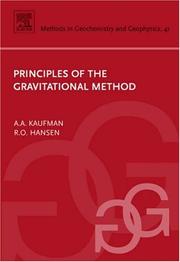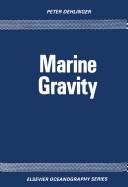| Listing 1 - 10 of 327 | << page >> |
Sort by
|
Multi
ISBN: 0128169370 9780128169377 9780128169360 0128169362 Year: 2021 Publisher: Amsterdam, Netherlands ;Cambridge, MA Elsevier
Abstract | Keywords | Export | Availability | Bookmark
 Loading...
Loading...Choose an application
- Reference Manager
- EndNote
- RefWorks (Direct export to RefWorks)
Gravity --- Measurement.
Book
ISBN: 0192536818 019253680X 9780192536808 9780198809111 0198809115 Year: 2018 Publisher: Oxford, United Kingdom
Abstract | Keywords | Export | Availability | Bookmark
 Loading...
Loading...Choose an application
- Reference Manager
- EndNote
- RefWorks (Direct export to RefWorks)
Today we are blessed with two extraordinarily successful theories of physics. The first is Albert Einstein's general theory of relativity, which describes the large-scale behaviour of matter in a curved spacetime. This theory is the basis for the standard model of big bang cosmology. The discovery of gravitational waves at the LIGO observatory in the US (and then Virgo, in Italy) is only the most recent of this theory's many triumphs. The second is quantum mechanics. This theory describes the properties and behaviour of matter and radiation at their smallest scales. It is the basis for the standard model of particle physics, which builds up all the visible constituents of the universe out of collections of quarks, electrons and force-carrying particles such as photons. The discovery of the Higgs boson at CERN in Geneva is only the most recent of this theory's many triumphs. But, while they are both highly successful, these two structures leave a lot of important questions unanswered. They are also based on two different interpretations of space and time, and are therefore fundamentally incompatible. We have two descriptions but, as far as we know, we've only ever had one universe. What we need is a quantum theory of gravity. Approaches to formulating such a theory have primarily followed two paths. One leads to String Theory, which has for long been fashionable, and about which much has been written. But String Theory has become mired in problems. In this book, Jim Baggott describes : an approach which takes relativity as its starting point, and leads to a structure called Loop Quantum Gravity. Baggott tells the story through the careers and pioneering work of two of the theory's most prominent contributors, Lee Smolin and Carlo Rovelli. Combining clear discussions of both quantum theory and general relativity, this book offers one of the first efforts to explain the new quantum theory of space and time.--
Periodical
ISSN: 23146907 23146907 Publisher: [S.l.] Hindawi Publishing Corporation
Abstract | Keywords | Export | Availability | Bookmark
 Loading...
Loading...Choose an application
- Reference Manager
- EndNote
- RefWorks (Direct export to RefWorks)
Gravity --- Gravity. --- Geophysics --- Mechanics --- Pendulum

ISBN: 128107117X 9786611071172 0080553877 0444529934 9780444529930 9780080553870 Year: 2008 Publisher: Amsterdam London
Abstract | Keywords | Export | Availability | Bookmark
 Loading...
Loading...Choose an application
- Reference Manager
- EndNote
- RefWorks (Direct export to RefWorks)
This self-contained monograph gives a thorough introduction to the theory of gravity which is used as the basis for developing applications in exploration and geodesy. In addition, a survey of gravity instrumentation is given, with emphasis on the theory of underlying these instruments. The book finishes with an exposition of forward modeling and inverston, again emphasizing fundamental principles.*Surveys gravity instrumentation with emphasis on the theory of why certain instrumentation is used*Presents thorough developments of the theory of gravity to aid in creating applications
Gravity. --- Gravity --- Measurement. --- Gravimetry --- Geophysics --- Mechanics --- Pendulum
Book
ISBN: 1608053997 9781608053995 1608054004 9781608054008 9781608054008 Year: 2012 Publisher: [Oak Park, Ill.] Bentham eBooks
Abstract | Keywords | Export | Availability | Bookmark
 Loading...
Loading...Choose an application
- Reference Manager
- EndNote
- RefWorks (Direct export to RefWorks)
This e-book attempts to answer one key question relating to gravity research: Is it possible to generate gravity-like fields by condensed-matter systems, in conditions accessible in a laboratory? General Relativity and lowest-order Quantum Gravity predict in this case very small emission rates, so these phenomena can only become relevant if some strong quantum effect occurs.
Gravity. --- Geophysics --- Mechanics --- Pendulum
Multi
ISBN: 0123852242 9780123852243 9780123852236 0123852234 Year: 2013 Publisher: Amsterdam Academic
Abstract | Keywords | Export | Availability | Bookmark
 Loading...
Loading...Choose an application
- Reference Manager
- EndNote
- RefWorks (Direct export to RefWorks)
Gravity waves exist in all types of geophysical fluids, such as lakes, oceans, and atmospheres. They play an important role in redistributing energy at disturbances, such as mountains or seamounts and they are routinely studied in meteorology and oceanography, particularly simulation models, atmospheric weather models, turbulence, air pollution, and climate research. An Introduction to Atmospheric Gravity Waves provides readers with a working background of the fundamental physics and mathematics of gravity waves, and introduces a wide variety of applications and numerous recent adva

ISBN: 9780444416803 0444416803 9780080870588 0080870589 1281772526 9781281772527 9786611772529 Year: 1978 Publisher: New York Distributors for the U.S. and Canada, Elsevier North-Holland
Abstract | Keywords | Export | Availability | Bookmark
 Loading...
Loading...Choose an application
- Reference Manager
- EndNote
- RefWorks (Direct export to RefWorks)
Marine Gravity
Book
Year: 2022 Publisher: Basel : MDPI - Multidisciplinary Digital Publishing Institute,
Abstract | Keywords | Export | Availability | Bookmark
 Loading...
Loading...Choose an application
- Reference Manager
- EndNote
- RefWorks (Direct export to RefWorks)
This edited collection explores current approaches to understanding space, time, and gravity within a quantum-theoretical framework. In most such approaches, the three-dimensional space of ordinary perception and action is physically fundamental, but is rather emergent from underlying structures or dynamics that can, in general, be described in terms of information flows. Processes such as measurement and computation are, therefore, fundamental to the notion of physical space.
Gravity. --- Quantum theory. --- Physics.
Book
ISBN: 3736982364 9783736982369 9783736992368 Year: 2016 Publisher: Göttingen Cuvillier Verlag
Abstract | Keywords | Export | Availability | Bookmark
 Loading...
Loading...Choose an application
- Reference Manager
- EndNote
- RefWorks (Direct export to RefWorks)
Book
ISBN: 3736960441 Year: 2019 Publisher: Göttingen : Cuvillier Verlag,
Abstract | Keywords | Export | Availability | Bookmark
 Loading...
Loading...Choose an application
- Reference Manager
- EndNote
- RefWorks (Direct export to RefWorks)
| Listing 1 - 10 of 327 | << page >> |
Sort by
|

 Search
Search Feedback
Feedback About UniCat
About UniCat  Help
Help News
News